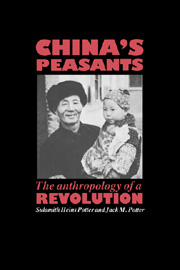Book contents
- Frontmatter
- Contents
- List of illustrations
- List of tables
- Preface
- Notes on the text
- Map 1 China
- 1 The old “feudal” order: Zengbu before Liberation
- 2 Establishing the new order
- 3 The ordeal of collectivization
- 4 The Cultural Revolution
- 5 Maoist society: the production team
- 6 Maoist society: the brigade
- 7 Maoist society: the commune
- 8 Impatient aspirations: transition to the post-Mao period
- 9 The cultural construction of emotion in rural Chinese social life
- 10 Marriage, household, and family form
- 11 Chinese birth planning: a cultural account
- 12 Lineage and collective: structure and praxis
- 13 Party organization
- 14 The party ethic: a devotion born of distress and enthusiasm
- 15 A caste-like system of social stratification: the position of peasants in modern China's social order
- 16 The Chinese peasants and the world capitalist system
- 17 The crystallization of post-Mao society: Zengbu in 1985
- References
- Index
10 - Marriage, household, and family form
Published online by Cambridge University Press: 02 December 2009
- Frontmatter
- Contents
- List of illustrations
- List of tables
- Preface
- Notes on the text
- Map 1 China
- 1 The old “feudal” order: Zengbu before Liberation
- 2 Establishing the new order
- 3 The ordeal of collectivization
- 4 The Cultural Revolution
- 5 Maoist society: the production team
- 6 Maoist society: the brigade
- 7 Maoist society: the commune
- 8 Impatient aspirations: transition to the post-Mao period
- 9 The cultural construction of emotion in rural Chinese social life
- 10 Marriage, household, and family form
- 11 Chinese birth planning: a cultural account
- 12 Lineage and collective: structure and praxis
- 13 Party organization
- 14 The party ethic: a devotion born of distress and enthusiasm
- 15 A caste-like system of social stratification: the position of peasants in modern China's social order
- 16 The Chinese peasants and the world capitalist system
- 17 The crystallization of post-Mao society: Zengbu in 1985
- References
- Index
Summary
Marriage, the household, and family organization are intimate and fundamental structures of social life. Since 1949, there have been some dramatic efforts to alter the nature of these structures in rural China. Yet, at the same time, many aspects of these deeply familiar structures are taken for granted as natural, inevitable, and beyond question (however arbitrary they may appear to the outsider) for they are an integral part of Chinese culture, and one does not pause to reevaluate processes that are as familiar as breathing. Furthermore, in the flux and shift of policy changes over the years, many choices have been made that tend to reinforce certain aspects of traditional patterns. Crane Brinton comments,
It is on the social arrangements that most intimately and immediately touch the average man [sic] that the actual changes effected by our revolutions seem slightest. The grand attempts at reform during the crisis period try to alter John Jones' relationship with his wife, his children, try to give him a new religion, new personal habits. The Thermidoreans [Brinton's term for those who direct a reaction against the “strain of prolonged effort to live in accordance with very high ideals” (1965, p. 203)] abandon most of this attempt, and in the end John Jones stands on certain matters about where he stood when the revolution began … in some very important ways the behavior of men changes with a slowness almost comparable to the kind of changes the geologist studies … (1965, pp. 243–244)
- Type
- Chapter
- Information
- China's PeasantsThe Anthropology of a Revolution, pp. 196 - 224Publisher: Cambridge University PressPrint publication year: 1990



